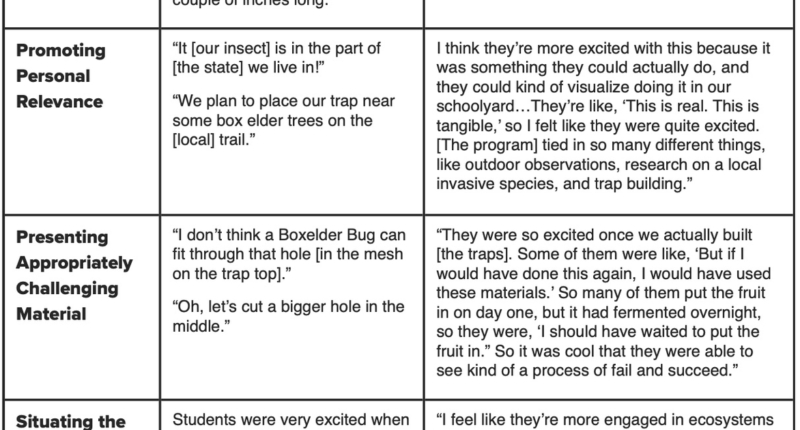Engineering design is an essential tool that identifies needs, wants, and problems, and provides solutions to address them. To promote sustained learning of STEM, programs must foster students’ engagement and motivation. Four design features that promote interest and motivation in STEM learning environments are providing choice or autonomy in learning, promoting personal relevance, presenting appropriately challenging material, and situating investigations in socially and culturally appropriate contexts. Our program emphasizes each of these design features and aligns its curricular elements with them to promote student engagement and motivation. Engineering design programs represent a vision for K-16 STEM education, providing learners with experiences that foster motivation, sustained engagement, and an appreciation for STEM. They also help learners find meaning and value when their STEM learning is used to solve local problems.
The Importance of Engineering Design for Learners
Engineering design plays a critical role in identifying needs, wants, and problems, and devising solutions to address them. This is important for learners of all ages, as it provides them with the tools and knowledge to address local and global problems. With funding from the U.S. National Science Foundation, programs like ours aim to promote sustained learning of Science, Technology, Engineering, and Mathematics (STEM) for students from primary school through university.
Identifying Needs through Engineering Design

Engineering design systematically identifies needs, wants, and problems and then devises solutions to address them. At our program, we guide students through a seven-step process that involves defining the problem, researching, designing, building, giving feedback, placing, and educating.
Using STEM to Develop Solutions
Our program aims to extend environmental science learning through the seven stages of engineering design, for youth ages 11-13. Students define the problem as a local invasive insect disrupting a local ecosystem, and research on one invasive insect to understand their food, habitat needs, and predators. Then, in teams, they brainstorm at least three designs for a trap that can collect their invasive insect. Feedback is given by sharing designs with other student teams and local environmentalists, and placing the traps in the most effective location and time of year. Finally, they synthesize key ideas from their designs to inform local stakeholders about possible implementation in their area.
The Significance of Pre-University Programs in STEM
The significance of pre-university programs that foster the engineered design of solutions is to make STEM learning appropriately challenging and relevant. It ensures that learners have the necessary tools and knowledge to address local and global problems, and promotes sustained learning of STEM throughout their academic journey.
In conclusion, engineering design is a vital tool for identifying and addressing needs, wants, and problems. It is important for learners of all ages as it equips them with the necessary tools and knowledge to address local and global problems. Through programs like ours, we hope to promote sustained learning of STEM and encourage learners to develop innovative solutions to the challenges they encounter.
Design Features that Promote Motivation in STEM Learning Environments
Research has shown that programs that support students’ engagement and motivation are essential for effective learning of science, technology, engineering, and mathematics (STEM) subjects. Motivation is a key driver for using STEM in critical decision-making processes (NASEM, 2018). The National Academies of Science, Engineering, and Mathematics (NASEM) suggests four design features that promote interest and motivation in STEM learning environments:
Design Features for Promoting Motivation in STEM Learning
-
Providing choice or autonomy in learning
-
Promoting personal relevance
-
Presenting appropriately challenging material
-
Situating the investigations in socially and culturally appropriate contexts.
Our program places emphasis on each of these four design features to promote student motivation and engagement. The table illustrates how the curricular program’s elements align with each design feature, as reported by students and teachers.
The Significance of Engineering Design Programs in STEM Education
Engineering design programs like ours represent a vision for K-16 STEM education as they provide learners with experiences that foster motivation, sustained engagement, and an appreciation for STEM. They enable learners to find meaning and value when using STEM learning to solve local problems.
In conclusion, designing STEM programs that promote student engagement and motivation is essential for effective learning of science, technology, engineering, and mathematics. The four design features identified by the National Academies of Science, Engineering, and Mathematics are critical to achieving this goal. Our program emphasizes these design features to foster student motivation and engagement, with the aim of promoting sustained learning of STEM throughout learners’ academic journey.
References
-
National Academies of Sciences, Engineering, and Medicine. 2018. Sciencecand Engineering for Grades 6-12: Investigation and Design at the Center. Washington, DC: The National Academies Press. https://doi.org/10.17226/25216.
-
National Academies of Sciences, Engineering, and Medicine. 2020. Building Capacity for Teaching Engineering in K–12 Education. Washington, DC: The National Academies Press. https://doi.org/10.17226/25612.
Don’t miss interesting posts on Famousbio









